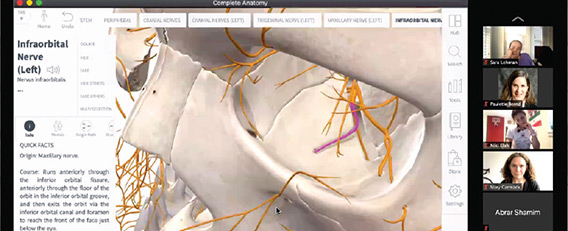Medical Education in a Pandemic
VP&S student Cody Slater had just finished his internal medicine rotation at NewYork-Presbyterian Hospital in March when the COVID-19 outbreak shut down New York City. Like other members of the VP&S Class of 2022, he was at the start of his Major Clinical Year, a sequence of clinical rotations that immerse students in different medical specialties in hospital settings.
“It was a stressful time,” recalls Mr. Slater. Without clinical rotations to fill his time, he was connected to a research project through Elizabeth Shane, MD, associate dean for student research, who identified COVID-19 research projects that were a good match for VP&S students.
Mr. Slater began work with Ruijun Chen, MD, a physician-researcher at Weill Cornell Medicine. He was one of 30 medical students who contributed to data collection efforts for the study and one of four medical students who were first authors on one of the resulting papers, “Characterization and Clinical Course of 1,000 Patients with Coronavirus Disease 2019 in New York: Retrospective Case Series,” that was published in the BMJ, an international research journal.
“By getting involved in the research, I felt like I knew what was happening at the hospital and it took my mind off other things,” says Mr. Slater.
“The resilience of our students, faculty, and staff has been phenomenal as everyone has had to reimagine medical training,” says Lisa Mellman, MD, interim co-vice dean for education and senior associate dean for student affairs at VP&S. “This period has shown that when faced with unprecedented challenges, we can all pull together and meet the needs at hand.”
From mid-March through June 2020, clinical education paused for most third- and fourth-year medical students. By July, students had returned to clinical rotations in a slightly abbreviated format to allow them to catch up after rotations were paused.
During the fall 2020 semester, pre-clinical education also changed at VP&S. First-year medical students were fully remote, participating in synchronous learning (online classes that are taken together and include interactive participation) and asynchronous learning (in which content is available online and students can access the materials when they wish). Anatomy was taught online in interactive large groups and smaller clinical correlation sessions. In-person dissection sessions are planned when students return to campus for the spring 2021 term.
Second-year medical students participated in a blended curriculum with in-person instruction in the simulation center and in the hospital to focus on clinical skills. Remote instruction accounted for the rest of their coursework. These students interacted in person with standardized patients using appropriate safety precautions and practiced their interviewing skills via remote sessions.
“There have been excellent lessons about instances in which remote instruction helps to harmonize teaching across sites and to facilitate bringing in instructors,” says Jonathan Amiel, MD, interim co-vice dean for education and senior associate dean for curricular affairs at VP&S. “We have also been accelerating the use of interactive online modules with preceptors providing ongoing feedback as cases develop, including a terrific COVID module that all first- and second-year students completed.”
With the COVID-19 pandemic and care delivery in health systems reaching a new equilibrium, third-year medical students resumed their clinical clerkships in late June. Many fourth-year students who spent several months starting their scholarly projects and participating in service-learning were able to resume sub-internships and senior electives in June. They will participate in a hybrid residency preparation course ahead of graduation in the spring.
The residency application process has changed to reflect the times. In May, the Coalition for Physician Accountability, a cross-organizational group of national medical education organizations, including the Association of American Medical Colleges, offered nationwide recommendations for students preparing for the 2020-21 residency cycle. The coalition recommended temporarily suspending away rotations at hospitals, moving forward with virtual interviews for all applicants to residency programs, delaying the start of the electronic residency application process, and delaying release of medical student performance evaluations.
In light of the recommendations, residency programs across the country have transformed their interview days. Residency applicants are offered virtual meet and greets, open houses, and tours of hospitals.
The VP&S mock interview program, which helps to prepare medical students for residency interviews, is also virtual this year. It now covers how to set up a personal interview space to look professional online and offers tips for making a positive impression with eye contact and body language on Zoom.
As for Mr. Slater, he continued with his Major Clinical Year and completed a summer rotation in primary care in the Bassett Healthcare System in Cooperstown, New York. “My classmates and I are training to become physicians during one of the most pivotal moments for health care in the last half-century,” says Mr. Slater. “While structural insufficiencies have always been present in medicine, our education is uniquely dominated by an awareness of these factors and how they disrupt health outcomes, even without the strain of a pandemic. I am confident we are already growing from this experience to help shape the next generation of health care, one in which accessibility and community engagement become equal partners with scientific discovery and technical innovation.”
— Rose Spaziani
- Log in to post comments


